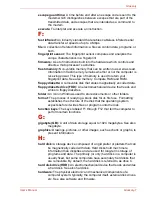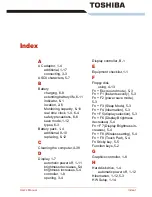
Glossary-10
User’s Manual
Glossary
non-system disk:
A disk for storing programs and data that cannot be
used to start the computer. Compare system disk.
nonvolatile memory:
Memory that is capable of permanently storing
information. Turning the computer’s power off does not alter data
stored in nonvolatile memory.
numeric keypad overlay:
A feature that allows you to use certain keys on
the keyboard to perform numeric entry, or to control cursor and page
movement.
O:
OCR:
Optical Character Recognition (reader). A technique or device that
uses laser or visible light to identify characters and input them into a
storage device.
online state:
A functional state of a peripheral device when it is ready to
receive or transmit data.
operating system:
A group of programs that controls the basic operation
of a computer. Operating system functions include interpreting
programs, creating data files, and controlling the transmission and
receipt (input/output) of data to and from memory and peripheral
device.
output:
The results of a computer operation. Output commonly indicates
data.
1) printed on paper, 2) displayed at a terminal, 3) sent through the
serial port of internal modem, or 4) stored on some magnetic media.
P:
parallel:
Processes that occur simultaneously. In communications, it
means the transmission of more than one bit of information at a
time. On your computer, the parallel port provides a parallel
communications interface between the computer and an
appropriate device. Compare serial.
parity:
1) The symmetrical relationship between two parameter values
(integers) both of which are either on or off; odd or even; 0 or 1.
2) In serial communications, an error detection bit that is added to a
group of data bits making the sum of the bits even or odd. Parity can
be set to none, odd, or even.
password:
A unique string of characters used to identify a specific user.
The computer provides various levels of password protection such
as user and supervisor.
PC card:
A credit-card-sized expansion card designed to increase the
capabilities of notebook computers. PC Cards provide functions
such as modem, fax/modem, hard disk drive, network adapter,
sound card, or SCSI adapter.
PCI:
Peripheral Component Interconnect. An industry standard 32-bit bus.
peripheral:
Any device, such as a printer or joystick, that is attached to the
computer and controlled by the computer's CPU.
pixel:
A picture element. The smallest dot that can be made on a display or
printer. Also called a pel.
Содержание SATELLITE L310
Страница 1: ...TOSHIBA Satellite M300 L310 Satellite Pro M300 L310 Portable Personal Computer User s Manual ...
Страница 34: ...xxxiv User s Manual Preface ...
Страница 52: ...1 18 User s Manual Introduction ...
Страница 74: ...2 22 User s Manual The Grand Tour ...
Страница 134: ...5 8 User s Manual The Keyboard ...
Страница 152: ...7 4 User s Manual HW Setup ...
Страница 190: ...9 24 User s Manual Troubleshooting ...
Страница 194: ...A 4 User s Manual Specifications ...
Страница 200: ...C 4 User s Manual Wireless LAN ...
Страница 220: ...Glossary 14 User s Manual Glossary ...
Страница 224: ...Index 4 User s Manual Index ...









































